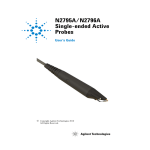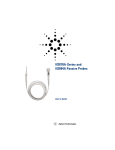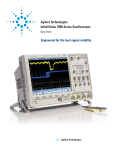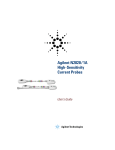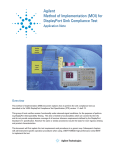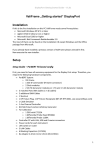Download Agilent Technologies N1022A User`s guide
Transcript
N2790A Differential Voltage Probe User’s Guide For Safety, Regulatory, and publishing information, see the pages at the back of this book. © Copyright Agilent Technologies 2009 All Rights Reserved. A Contents Inspecting the Probe 3 Compatibility 4 Probe Parts Supplied 5 Characteristics and Specifications 6 Cleaning the Probe 8 Using the N2790A Probe 9 Service Strategy 10 Characterization Plots 11 Calibration Testing Procedures 12 2 Inspecting the Probe Inspecting the Probe ❏ Inspect the shipping container for damage. Keep a damaged shipping container or cushioning material until the contents of the shipment have been checked for completeness and the probe has been checked mechanically and electrically. ❏ Check the accessories. Any accessories that were supplied with the probe are listed in the “Probe Parts Supplied” section of this manual. • If the contents are incomplete or damaged, notify your Agilent Technologies Sales Office. ❏ Inspect the instrument. • If there is mechanical damage or defect, or if the probe does not operate properly or pass calibration tests, notify your Agilent Technologies Sales Office. • If the shipping container is damaged, or the cushioning materials show signs of stress, notify the carrier as well as your Agilent Technologies Sales Office. Keep the shipping materials for the carrier’s inspection. The Agilent Technologies office will arrange for repair or replacement at Agilent Technologies’ option without waiting for claim settlement. 3 Inspecting the Probe N2790A Differential Voltage Probe The N2790A differential probe allows you to safely measure high-voltage floating circuits with the oscilloscope grounded. It is ideal for many applications such as motor speed controls, power supply designs, and electronic high-power converters. The N2790A offers sufficient dynamic range and bandwidth for your application to make the floating measurements found in high-speed power electronic circuits safely and accurately. With 100 MHz bandwidth, switchable attenuation of 50:1 and 500:1, and a maximum differential voltage input of 1400V (DC + peak AC), it provides the versatility for a broad range of applications including high-voltage circuits. Each probe comes with sharp browser probe tips for use on small components and in tight places, alligator clips for connecting to larger cables, and pincher clips. The probe is powered by the autoprobe interface. Compatibility The N2790A differential probe is compatible with the following Agilent oscilloscopes: • InfiniiVision Series 5000, 6000 (except 100 MHz), and 7000 with version 5.2 software or later • Infiniium 9000 (with version 2.00 software or later), 8000 (with version 5.61 software or later), and 54830 Series (with version 5.61 software or later) 4 Inspecting the Probe Probe Parts Supplied The following diagram and table show the parts supplied with the N2790A Probe. 2 3 4 The probe tips you receive may look slightly different than the ones shown in this picture. Parts for N2790A Probe Item 1 2 Description Part Number Differential voltage probe N2790-68701 Probe tips - browser tip (x2) A054* (black and red pair) 3 Probe tips - pincher clip (x2) (black and red pair) 4 Probe tips - alligator plunger clip (x2) (black and red pair) 5 Plastic pouch 6 Offset adjustment tool To order the Probe Tip Accessory Kit (consisting of 2 browser tips, 2 pincher clips, and 2 alligator plunger tips), order part number N2790-68700. Probe tips are only for use with the N2790A differential voltage probe. *Probe tips are not orderable separately. 5 Characteristics and Specifications Characteristics and Specifications Characteristics and specifications for the N2790A Differential Voltage Probe are shown below. Electrical Characteristics Attenuation ratios Bandwidth (-3 dB)* Gain Accuracy* DC CMRR AC CMRR Input impedance Noise referenced to input Propagation Delay Switch positions Internal power 50:1 and 500:1 (Selectable via switch on probe.) 100 MHz \4% @ 0-20 oC, \2% @ 20-30 oC, \4% @ 30-55 oC -70 dB @ 500VDC -80 dB @ 50/60 Hz -50 dB @ 100 kHz -50 dB @ 1 MHz Between inputs: 8 M Ω , 3.5 pF < 300 mVrms @ 500:1 < 50 mVrms @ 50:1 14.0 ns @ 50:1, 12.8 ns @ 500:1 500:1, 50:1 Autoprobe interface *Denotes warranted specification after 20 minute warm-up Input Characteristics Cable length Length of input leads Maximum common mode operating voltage (rms or DC + peak AC)1 Maximum common mode operating voltage derating frequency2 Maximum differential mode operating voltage (DC + peak AC)1 1Refer 2 2 MHz 1400 V @ 500:1 140 V @ 50:1 to the warnings on page 8 for further details on the input voltage safety rating. Refer to the derating plot on page 12 6 170 cm (66.9 inches) 40 cm (15.7 inches) 600V CAT III 1000V CAT II Characteristics and Specifications Output Characteristics Output cable Maximum output voltage range Safety designed BNC cable \2.8 V into 1 M Ω at 500:1 Environmental Specifications Temperature Altitude Humidity Pollution Degree Operating: -10 °C to +50 °C Nonoperating: -51 °C to +71 °C Operating: 2,000 m (6,561 ft) Nonoperating: 15,300 m (50,200 ft) Operating: 80% room humidity @ 40 °C Nonoperating: 90% room humidity @ 65 °C Pollution Degree 2 Safety Specifications Compliant with: IEC 61010-031 7 Cleaning the Probe W A R N I N G SHOCK HAZARD! These probes are designed for use with oscilloscopes that have a common terminal at GROUND POTENTIAL (in accordance with OSHA requirements and ! the National Electric Code). Exposed metallic surfaces of the probe and the oscilloscope MUST BE GROUNDED. Failure to ground the common terminal during certain applications, such as those requiring the oscilloscope to be powered from an external battery, might expose the operator to an electrical shock hazard that could be lethal (depending on voltage and current conditions.) ! ! The probe inputs are safety rated to a maximum of 1000 Vrms CAT II and 600 Vrms CAT III between either input and earth ground. These maximum ratings apply regardless of the attenuation setting of the probe. Do not apply voltages greater than 1000 Vrms CAT II or 600 Vrms CAT III between either input and ground. The probe tips that are provided are rated for 1000 Vrms CAT II and 600 Vrms CAT III usage. Other probe tips may be used if they have the appropriate ratings and the same style connectors. Cleaning the Probe Disconnect the probe from all power sources and clean it with a soft cloth dampened with a mild soap and water solution. Be careful not to get water in the attenuation switch. Make sure the probe is completely dry before reconnecting it to a power source. 8 Using the N2790A Probe Using the N2790A Probe Powering the N2790A The N2790A probe is powered by the autoprobe interface found on Agilent InfiniiVision and Infiniium Series oscilloscopes. Selecting the Correct Attenuation on the Probe and the Oscilloscope The probe has two modes of operation, 50:1 and 500:1 attenuation. Select the desired attenuation on the probe (via the switch on the probe) and the correct probe attenuation setting on the oscilloscope. This will ensure that accurate voltage readings can be made directly from the oscilloscope. Adjusting the Probe Offset Level The probe offset level is adjusted using the tool provided with the N2790A probe. Adjust the offset level by turning the potentiometer adjustment located on the autoprobe pod. Measurement Tips • Use the 50:1 range on the differential voltage probe for smaller signals, such as ripple on a high voltage reference lead. • Connect the red probe cable to a more positive or more negative voltage level than the black probe cable. • There is an overrange LED on the probe to indicate when you have exceeded the maximum voltage of the probe. 9 Service Strategy Service Strategy For repair, calibration, and to ensure the N2790A performs to its warranted specifications, send the probe to an Agilent Service Center for calibration testing procedures. The probe should be tested once a year or as required by other standards. If repair is needed and the N2790A is under warranty, normal warranty services will apply. If the N2790A is not under warranty, repair costs will be applied. To return the Probe to Agilent Technologies for Service Call (877) 477-7278 for further details and the location of your nearest Agilent Technologies Service Office. 1 Write the following information on a tag and attach it to the probe. • Name and address of the owner • Probe model number • Description of service required or failure indication 2 Retain all accessories. 3 Return the probe in its case or pack the probe in foam or other shock-absorbing material and place it in a strong shipping container. You can use the original shipping materials or order materials from an Agilent Technologies Sales Office. If neither are available, place 3 to 4 inches of shock-absorbing material around the instrument and place it in a box that does not allow movement during shipping. 4 Seal the shipment container securely. 5 Mark the shipping container as FRAGILE. In all correspondence, refer to the instrument by model number and full serial number. 10 Characterization Plots Characterization Plots dB Vout 6 Vout/Vin 3 0 -3 Vin -6 -9 BW(-3dB) = 147 MHz 6 7 10 8 10 10 Frequency (Hz) Graph of dB(Vin), dB(Vout), and dB(Vout/Vin) frequency response -30 -40 -50 dB -60 -70 -80 10 7 8 10 Frequency (Hz) Graph of dB (Vout/Vin) frequency response when inputs driven in common (common mode rejection) 11 Calibration Testing Procedures 10 10 4 3 Vrms 10 10 2 1 10 0 10 1 10 2 10 3 10 4 10 5 10 6 10 7 10 8 Frequency Derating plot - above 2 MHz, the maximum input operating voltage decreases as the frequency increases. Calibration Testing Procedures These procedures are used to test the warranted specifications for the N2790A Differential Probe. The recommended calibration test interval for the N2790A is once a year or as required. Use the equipment listed in the “Test Equipment Required” section to complete the Calibration Testing Procedures. Required Test Equipment Description Multimeter Oscilloscope Calibrator Programmable Function Generator External Power Supply Probe Power Extension Cable Autoprobe Interface Adapter Outside Thread 3.5 mm (male) to 3.5 mm (female) adapter Adapter Minimum Requirements 8.5 digits of resolution 500 MHz DC Voltage 0 to ± 1100 V 240 MHz sine wave No substitute No substitute No substitute No substitute Part Number 3458A Agilent DSO7054A Fluke 5700A 81150A Agilent 1143A Agilent 01143-61602 Agilent N1022A Agilent 5062-1247 SMA (m) to BNC (f) Cable BNC (m) to BNC (m) Agilent E2655-83201 (in E2655B kit) Agilent 8120-1838 12 Calibration Testing Procedures Description N2790A probe Adapter Adaptation 2 Minimum Requirements Part Number BNC (f) to banana (m) 50 W termination + BNC (m) to banana (f) Agilent 1251-2277 Setup Files for testing Setup for Bandwidth at 100 MHz, 50:1 Setting on Probe CH1 ON CH1 Sensitivity 100 mV/div, AC Timebase 20 ns/div BWL (Bandwidth Limiter) OFF Trigger on CH1 Setup for Bandwidth at 100 MHz, 500:1 Setting on Probe CH1 ON CH1 Sensitivity 10 mV/div, AC Timebase 20 ns/div BWL (Bandwidth Limiter) OFF Trigger on CH1 Test Gain 1 Connect the N2790A probe output to the N1022A adapter. 2 Connect the N1022A adapter to the 3458A multimeter via the outside 3 4 5 6 7 8 9 thread 3.5 mm (male) to 3.5 mm (female) adapter, SMA (m) to BNC (f) adapter, BNC (m) to BNC (m) cable, and BNC (f) to banana (m) adapter. Connect the N1022A adapter to the 1143A power supply via the 0114361602 cable. Connect the red end of the N2790A probe to the calibrator HI output. Connect the black end of the N2790A probe to the calibrator LO output. Measure the output at 50:1 and 500:1 with the calibrator set to 0 V. This is the probe offset. Measure the output as shown in the table below. Verify the value is between the 3458A limits listed in the table below for each output signal at each probe setting. Note: These limits assume zero offset. The limits should be adjusted for actual offset. Record the value displayed on the 3458A in the Calibration Test Record 13 Calibration Testing Procedures Test Gain Calibrator Output Signal DC N2790A Setting +10 V 50:1 3458A Reading Limits Gain +100 V 50:1 +1.96 V ... +2.04 V (\2% of reading) Gain +100 V 500:1 +196 mV ... +204 mV (\2% of reading) Gain +1000 V 500:1 +1.96 V ... +2.04 V (\2% of reading) Gain -10 V 50:1 -196 mV ... -204 mV (\2% of reading) Gain -100 V 50:1 -1.96 V ... -2.04 V (\2% of reading) Gain -100 V 500:1 -196 mV ... -204 mV (\2% of reading) Gain -1000 V 500:1 -1.96 V ... -2.04 V (\2% of reading) +196 mV ... +204 mV (\2% of reading) Test Bandwidth Connect the N2790A output to CH1 of the oscilloscope. Connect adaptation 2 to the 81150A function generator output. Connect the red N2790A probe tip to the red banana jack. Connect the black N2790A probe tip to the black banana jack. Load the appropriate setup file. Verify the value complies with the oscilloscope limits listed in the table below for each output signal at each probe setting. 7 Record the value displayed on the oscilloscope in the Calibration Test Record 1 2 3 4 5 6 Test 81150A Output Signal Bandwidth Bandwidth Sine wave, 100 MHz, 20 Vpp 50:1 Sine wave, 100 MHz, 20 Vpp 500:1 14 N2790A Setting Oscilloscope setup & limits Recall setup 1: > 2.8 div Recall setup 2: > 2.8 div Calibration Test Record Calibration Test Record Agilent Technologies N2790A 100 MHz Differential Probe Serial No.:_______________________ Certification Date:_________________ Tested By:_______________________ Recommended Test Interval: 1 Year Recommended Date of Next Certification:_________ Certification Temperature:_____________________ _______________________________ _______________________________ Test Probe Settings Limits Gain 50:1 +196 mV ... +204 mV (\2% of reading) Gain 50:1 +1.96 V ... +2.04 V (\2% of reading) Gain 500:1 +196 mV ... +204 mV (\2% of reading) Gain 500:1 +1.96 V ... +2.04 V (\2% of reading) Gain 50:1 -196 mV ... -204 mV (\2% of reading) Gain 50:1 -1.96 V ... -2.04 V (\2% of reading) Gain 500:1 -196 mV ... -204 mV (\2% of reading) Gain 500:1 -1.96 V ... -2.04 V (\2% of reading) Bandwidth 50:1 > 2.8 div Reading on oscilloscope Bandwidth 500:1 > 2.8 div Reading on oscilloscope Results 15 Safety Notices This apparatus has been designed and tested in accordance with IEC Publication 1010, Safety Requirements for Measuring Apparatus, and has been supplied in a safe condition. This is a Safety Class I instrument (provided with terminal for protective earthing). Before applying power, verify that the correct safety precautions are taken (see the following warnings). In addition, note the external markings on the instrument that are described under "Safety Symbols." Warnings • Before turning on the instrument, you must connect the protective earth terminal of the instrument to the protective conductor of the (mains) power cord. The mains plug shall only be inserted in a socket outlet provided with a protective earth contact. You must not negate the protective action by using an extension cord (power cable) without a protective conductor (grounding). Grounding one conductor of a two-conductor outlet is not sufficient protection. • Only fuses with the required rated current, voltage, and specified type (normal blow, time delay, etc.) should be used. Do not use repaired fuses or short-circuited fuseholders. To do so could cause a shock or fire hazard. • If you energize this instrument by an auto transformer (for voltage reduction or mains isolation), the common terminal must be connected to the earth terminal of the power source. • Whenever it is likely that the ground protection is impaired, you must make the instrument inoperative and secure it against any unintended operation. • Service instructions are for trained service personnel. To avoid dangerous electric shock, do not perform any service unless qualified to do so. Do not attempt internal service or adjustment unless another person, capable of rendering first aid and resuscitation, is present. • Do not install substitute parts or perform any unauthorized modification to the instrument. • Capacitors inside the instrument may retain a charge even if the instrument is disconnected from its source of supply. • Do not operate the instrument in the presence of flammable gasses or fumes. Operation of any electrical instrument in such an environment constitutes a definite safety hazard. • Do not use the instrument in a manner not specified by the manufacturer. To clean the instrument If the instrument requires cleaning: (1) Remove power from the instrument. (2) Clean the external surfaces of the instrument with a soft cloth dampened with a mixture of mild detergent and water. (3) Make sure that the instrument is completely dry before reconnecting it to a power source. Agilent Technologies P.O. Box 2197 1900 Garden of the Gods Road Colorado Springs, CO 80901 Safety Symbols ! Instruction manual symbol: the product is marked with this symbol when it is necessary for you to refer to the instruction manual in order to protect against damage to the product.. Hazardous voltage symbol. Earth terminal symbol: Used to indicate a circuit common connected to grounded chassis. Notices © Agilent Technologies, Inc. 2009 No part of this manual may be reproduced in any form or by any means (including electronic storage and retrieval or translation into a foreign language) without prior agreement and written consent from Agilent Technologies, Inc. as governed by United States and international copyright laws. Manual Part Number N2790-97000, June 2009 Print History N2790-97000, June 2009 Agilent Technologies, Inc. 1900 Garden of the Gods Road Colorado Springs, CO 80907 USA ing but not limited to the implied warranties of merchantability and fitness for a particular purpose. Agilent shall not be liable for errors or for incidental or consequential damages in connection with the furnishing, use, or performance of this document or of any information contained herein. Should Agilent and the user have a separate written agreement with warranty terms covering the material in this document that conflict with these terms, the warranty terms in the separate agreement shall control. Technology Licenses The hardware and/or software described in this docuRestricted Rights Legend ment are furnished under a If software is for use in the performance of a U.S. Govern- license and may be used or copied only in accordance ment prime contract or subwith the terms of such contract, Software is license. delivered and licensed as “Commercial computer software” as defined in DFAR 252.227-7014 (June 1995), or as a “commercial item” as defined in FAR 2.101(a) or as “Restricted computer software” as defined in FAR 52.227-19 (June 1987) or any equivalent agency regulation or contract clause. Use, duplication or disclosure of Software is subject to Agilent Technologies’ standard commercial license terms, and non-DOD Departments and Agencies of the U.S. Government will receive no greater than Restricted Rights as defined in FAR 52.227-19(c)(12) (June 1987). U.S. Government users will receive no greater than Limited Rights as defined in FAR 52.227-14 (June 1987) or DFAR 252.2277015 (b)(2) (November 1995), as applicable in any technical data. Document Warranty The material contained in this document is provided “as is,” and is subject to being changed, without notice, in future editions. Further, to the maximum extent permitted by applicable law, Agilent disclaims all warranties, either express or implied, with regard to this manual and any information contained herein, includ- WARNING A WARNING notice denotes a hazard. It calls attention to an operating procedure, practice, or the like that, if not correctly performed or adhered to, could result in personal injury or death. Do not proceed beyond a WARNING notice until the indicated conditions are fully understood and met. CAUTION A CAUTION notice denotes a hazard. It calls attention to an operating procedure, practice, or the like that, if not correctly performed or adhered to, could result in damage to the product or loss of important data. Do not proceed beyond a CAUTION notice until the indicated conditions are fully understood and met. A Agilent Technologies Printed in Japan Manual Part Number N2790-97000 *N2790-97000*




















